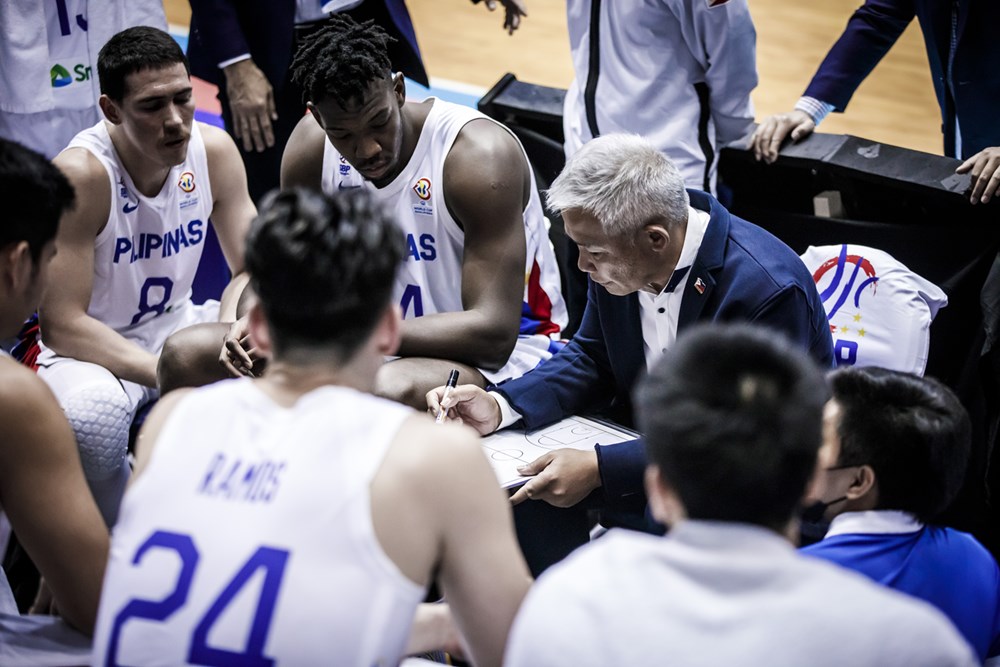
FILE–Gilas Pilipinas coach Chot Reyes during a huddle in the 2023 Fiba World Cup Asian Qualifiers here. FIBA PHOTO
A J-curve is any of J-shaped figures used in anything from economics to politics that depict a curve that slopes downwards before spiking back up, higher than its original staring point.
It’s a figure coach Chot Reyes recently referenced when calling for patience amid the debacles suffered by Gilas Pilipinas to explain the arc of the national team’s progress as it prepares for the Fiba World Cup next year.
Essentially, the J-curve is used to illustrate a trend: ““[T]hings will get worse first,” Reyes said, “… before it gets better beyond what it was.”
Don’t hold your breath, not even with a needless Senate inquiry on the horizon.
The problems hounding Gilas Pilipinas now has little do with Reyes’ ability as a coach than it has to do with firmly-rooted systems.
First, there’s the weakness of our national federations.
We look at the Samahang Basketball ng Pilipinas (SBP) and we see a federation with the financial might that is the envy of other national sports associations not named Philippine Football Federation (PFF).
But all that monetary muscle cannot purchase for the SBP control over its stakeholders.
Recently, those stakeholders banded together to pledge support to Gilas Pilipinas’ participation in the World Cup. After all, the country is hosting the global basketball showcase and about P1 billion in private cash will be spent locally for the event.
The PBA will adjust its calendar while the UAAP and NCAA will release players needed for the national pool.
But what about after the World Cup? For how long will that show of unity last?
The PBA will continue to be an ally of the SBP, yes, but the pro league is merely accommodating national interest—not because it is dictated upon by the national federation to do so.
The collegiate leagues? If it were easy to pull talents away from school teams for the national program, the Philippine National Volleyball Federation (PNVF) would have the full complement of young players it wants for a national pool.
“We are in constant communication with them,” said a hopeful PNVF board member Ricky Palou, talking about schools that haven’t fully committed to the plan of training young standouts during the college offseason. “We understand their concerns but hopefully, they’ll understand what we are trying to do here.”
The PFF is fortunate. Apart from the rich subsidies it gets from its international federation (Fifa), football president Mariano Araneta Jr. has one thing that all other national federation heads would die to have: A greater control of his sport.
So basketball’s dilemma is both a nurture and nature problem. The people who are supposed to take care of the sport are basically kneecapped by their lack of jurisdiction in an already established sovereignty.
If you ask him, though, Araneta will say the organizational spine of the PFF lies in a higher power.
“Everything starts with Fifa,” Araneta told the Inquirer. “Their management of the sport and the way they take care of the national federations, big or small, is really topnotch. We are following the Fifa’s lead here.”
He has a point: Even the most moneyed and powerful European clubs bow to Fifa.
Araneta refuses to make comparisons between his federation and other sports associations. But he doesn’t have to—the difference is stark. The PFF runs its singular pro league (one for men, one for women). College tournaments need the PFF for accredited referees and proper sanctions. Players can’t switch clubs without transfer certificates issued by the PFF.
Most of all, footballers see the national team as a gateway to lucrative club contracts, not as a necessary nuisance to their pro careers.
Imagine if the SBP could wield such administrative powers.
And then there is that rarely discussed yet just as insidious system: The fact that collegiate basketball and volleyball stars are essentially pros. The finest talents are furnished with perks—cash or otherwise (including employment for family members)—that binds them to their schools like Grade A adhesive.
Sure, the national team offers wages, too. But even for Gilas Pilipinas, which pays rich allowances and bonuses, those perks are usually one-shot deals. A collegiate contract can last five years. Do the math and figure out how that situation will progress.
Senate inquiry? The only possible legislation that could save the situation is one that will force the hand of all of sports’ stakeholders to release players drafted by national programs. Club teams, schools—no one can hold on their stars once the national team comes calling.
It is a law Philippine Olympic Committee (POC) president Bambol Tolentino already proposed, without having to host a hearing. It is also a law that would bark loud, but inevitably lack bite: Clubs and schools can always pass the burden of turning down national team invites to the players.
So basketball’s dilemma is both a nurture and nature problem. The people who are supposed to take care of the sport are basically kneecapped by their lack of jurisdiction in an already established sovereignty. And to remedy that would be to overhaul a system so entrenched it would need a miraculous-level intervention from those who benefit from that structure—schools, clubs, players, agents, sponsors, broadcast partners, families.
So that upward curve? If you’re talking about Gilas Pilipinas the team, maybe that is possible. In 2023, the national team could score the wins it needs to get out of the group stage and join the knockout phase of the World Cup.
Perhaps that would be the “J” vindication Reyes and the SBP need.
Gilas Pilipinas the program? Unless there is a near-improbable major system remodel starting from the very top of basketball’s leadership, then we’re really looking at a U-curve here. After things get bad, the upward tick will only bring us back to where we started.
Go ahead. Try legislate a solution to that, Senate.

